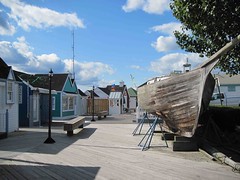SoundVision: Lumpy Conditions on a Beautiful Sail Out of Old Saybrook

I can’t make believe I was bummed earlier today when I got the word that Saturday’s SoundVision event in Mystic was being cancelled because of the weather. The crew of the Schooner SoundWaters had already pretty much decided to bag it and head back to a safe berth in Stamford in seas that were already lumpy (more about that later), and so the only thing on Saturday’s schedule was the press conference, which would have meant a round-trip drive of about four hours and 200 miles for a half-hour event. In the rain. And let’s face it, how many reporters are there in eastern Connecticut who would have shown up at 3 p.m. on a Saturday anyway?
So I’ll stay home and for part of the time anyway I’ll probably think back to yesterday’s SoundVision event, in Old Saybrook. It was the fifth SoundVision event this month and at the first four, the two-hour sail that was to follow the press conference was called off because the radar map showed pockets of thunder storms nearby.
Yesterday the weather was fine, though breezy. And so the show went on, with the promise of a reward in the form of a two-hour sail aboard the Schooner SoundWaters.
But first the press conference. Curt Johnson of Save the Sound made the point, as always, that the SoundVision plan was a unanimous production of the Long Island Sound Study’s Citizens Advisory Committee, which includes environmentalists, planners, business people, scientists and more (for all the details, click here). SoundVision, he said, is not just environmentalism:
"This is not an environmental agenda. This is an economic agenda, a business agenda, an agenda for a cleaner and healthier Sound for the next generation."
And then, as always, he introduced the speakers: Michael Pace, Old Saybrook’s first selectman; Congressman Joe Courtney; State Representatives Marilyn Giuliano and Phil Miller; State Senator Ed Meyer; Betsey Wingfield, of the state Department of Energy and Environmental Protection; Jacqueline Talbot and Andrea Donlon, of the Connecticut River Watershed Council; Richard Potvin, of the U.S. Fish and Wildlife Service; Linda Krause, of the Connecticut River Estuary Regional Planning Agency; and Stephen Tagliatela, the owner of the Saybrook Point Inn and Marina, which is where we were.
Most said something interesting, and even those who didn’t were concise. Among the things that interested or amused me:
Senator Meyer derided a land swap that gave a developer 17 riverfront acres owned by the state in Haddam in exchange for land elsewhere in that town. The legislature and governor approved it, over the objections of Meyer and Miller, among others.
Stephen Tagliatela pointed out that marinas in Connecticut are hardly thriving and could use help from the state government to overcome a competitive advantage held by Rhode Island.
Andrea Donlon said that since 2000, riverfront communities in Massachusetts have made improvements to their sewers that prevented a billion gallons of raw sewage a year from being dumped into the river and yet there is still 741 million gallons a year to remove.
And her colleague, Jacqueline Talbot, spoke pretty much for everybody when she took the mike, the Connecticut River a rich blue behind her, and said, “This beats being in the office.”
An hour or so later the SoundWaters slipped away from the dock, passed a couple of enormous cabin cruisers, and headed for the channel between the breakwaters. The wind was brisk. The low sun made it hard to look west. We motored past the old Saybrook Light and then the new Saybrook Light, and by that time the schooner was hitting turbulence. This was of interest to me, because I’m prone to seasickness. Dianne Selditch of SoundWaters informed me: “I just heard that the word they use for this is lumpy,“ which was a new one for both of us. The sea was indeed lumpy. And rocky and rolly as well.
I tried to enjoy the wind and take in as much oxygen as my lungs could handle. I watched the crew raise two of the three sails (in that wind, three would have been excessive) and enjoyed the quiet that came when the engines were cut. Long Island Sound seemed oceanic. To take my mind off the lumpiness, I chatted with some of the others on board.
I asked the SoundWaters captain, Justin Cathcart, about the difference between a schooner and a sloop, which seemed understandable enough -- two or three masts for a schooner, one for a sloop -- until he started talking about brigs and barks and yawls and ketches, and I lost him. I talked with Andrea Donlon, who drove from Greenfield, Massachusetts, about the 400th anniversary of Adriaen Block’s “discovery” of the river (and Long Island Sound), which no one is making a big deal of. Suzy Allman, who drove from Rye to shoot footage for a video she is making, said the Sound needed a version of the Hudson’s Pete Seeger, to rally people; Justin suggested Billy Joel but then backtracked because Billy Joel apparently is selling his boats and buying motorcycles instead.
And then we hairpinned in the middle of the Sound and headed back to the mouth of the river, moving fast in the wind and on the flood tide. It was obvious I was not going to get sick, nor was anyone else. We sailed past our dock, watched an Amtrak train move noiselessly across the railroad draw bridge, and then turned and headed back. By 7, on schedule, we were at the dock. I drove home in the fading twilight, the sky big and beautiful as the sun set, like a 21st century Hudson River School painting over the industrial waterfront of New Haven.
Labels: SoundVision













